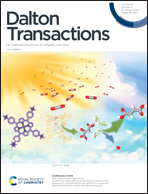Ruthenium(ii) complexes with phosphonate-substituted phenanthroline ligands as reusable photoredox catalysts†
Abstract
Ru(II) complexes with polypyridyl ligands (2,2′-bipyridine = bpy, 1,10-phenanthroline = phen) play a central role in the development of photocatalytic organic reactions. In this work, we synthesized four mixed-ligand [Ru(phen)(bpy)2]2+-type complexes (Ru-Pcat-A) bearing two phosphonate substituents P(O)(OH)(OR) (R = H, Et) attached to the phen core at positions 3,8 (Ru-3,8PH and Ru-3,8PHEt) and 4,7 (Ru-4,7PH and Ru-4,7PHEt) of the heterocycle in high yields (87–99%) and characterized them using spectral methods. Single crystal X-ray diffraction was employed to determine the coordination mode of the ditopic phen ligand in Ru-4,7PH. This complex exists as the neutral species and forms a 1D hydrogen-bonded framework in the crystals. The light absorption characteristics were found to be similar for all complexes prepared in this work. However, the emission maxima in aqueous solutions were significantly affected by the substitution of the heterocycle, ranging from 629 nm for Ru-4,7PH to 661 nm for Ru-3,8PHEt. The emission quantum yields in Ar-saturated deionized water showed a strong dependence on the substitution pattern of the phen ligand, with maximal values reaching approximately 0.11 for Ru-4,7PHEt and Ru-4,7PH, which is twice as high as that of the classical [Ru(bpy)3]2+ complex (Ru-bpy). The photocatalytic performance of Ru-Pcat-A was investigated using visible light photoredox catalytic transformations of tertiary amines. With Ru-Pcat-A, we achieved the phosphonylation of N-aryl-1,2,3,4-tetrahydroisoquinolines (THIQs) and cyanation of THIQs and N,N-dimethylaniline in methanol, while a mixture of nitromethane/methanol (1 : 1 v/v) proved to be the optimal solvent for conducting the nitromethylation of THIQs. In the majority of the studied reactions, Ru-4,7PHEt exhibited greater efficiency compared to Ru-bpy, and it could be easily separated from the products using water extraction and reused in the next catalytic cycle. We successfully performed seven consecutive nitromethylation and phosphonylation of N-phenyl-1,2,3,4-tetrahydroisoquinoline using the recycled homogeneous photoredox catalyst.



 Please wait while we load your content...
Please wait while we load your content...